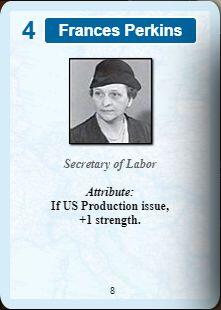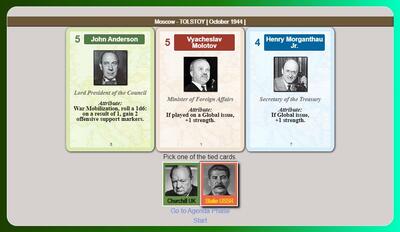
Churchill: Big Three Struggle of Peace
 By late 1942 the Axis had been stopped at Stalingrad, El Alamein, and Guadalcanal. With Axis expansion halted and Allied victory only a matter of time and resources Churchill, Roosevelt, and Stalin began to focus on how to shape the ensuing peace to their advantage. Churchill is a game about the inter-Allied conflicts that occurred over the Conference table as each side vies to control the Allied agenda and the course of things to come.
By late 1942 the Axis had been stopped at Stalingrad, El Alamein, and Guadalcanal. With Axis expansion halted and Allied victory only a matter of time and resources Churchill, Roosevelt, and Stalin began to focus on how to shape the ensuing peace to their advantage. Churchill is a game about the inter-Allied conflicts that occurred over the Conference table as each side vies to control the Allied agenda and the course of things to come.
The players in the game take on the roles of Churchill, Roosevelt, or Stalin as they maneuver against each over the course of 5 or 10 Conferences that determine who will lead the Allied forces, where those forces will be deployed, and how the Axis will be defeated. The player whose forces collectively have greater control over the surrendered Axis powers will win the peace and the game.
Churchill is a one to three player game of Coop-etition where the players must cooperate to win World War II, while at the same time achieving a superior post war position over your allies. If the players collectively fail to defeat the Axis the Allies lose, but if the Axis are defeated, there is a victor of the peace that follows.
Resources:
- Churchill introduction (YouTube.com)
- Churchill details (Boardgamegeek.com)
- Educational Materials for Integrating the Game into the Classroom

How to Have Students Play as a Group Online
One of the advantages of playing a boardgame in a classroom, even a solitaire game like Israeli, is that students can collaborate in pairs or even small groups. This has the advantages of ensuring that even students who are unclear about the activity or the game rules can be guided by the other students, and the students can discuss and debate both the moves to make and the events of the game. The online environment makes this more difficult, but it is certainly not impossible. We'll use Zoom an example.

Imagine you are using Zoom to teach a class of a couple dozen students synchronously. You've been discussing the end of World War II and the postwar world and introduced students to the game, but you want them to work together on the game in pairs or groups of 3 or 4. You can break students into groups on Zoom as you would normally, but before you do, identify those students who are going to be the Game Master (or GM, or Host). The Host student opens the game in their computer's browser and then shares their screen with the group. Everyone will be able to see the Host's screen with the game. (Don't forget to play fullscreen -- the "F11" key.) Students can then discuss moves and events with the Host taking the actions the group desires.
This site provides information using PDF, visit this link to download the Adobe Acrobat Reader DC software.
